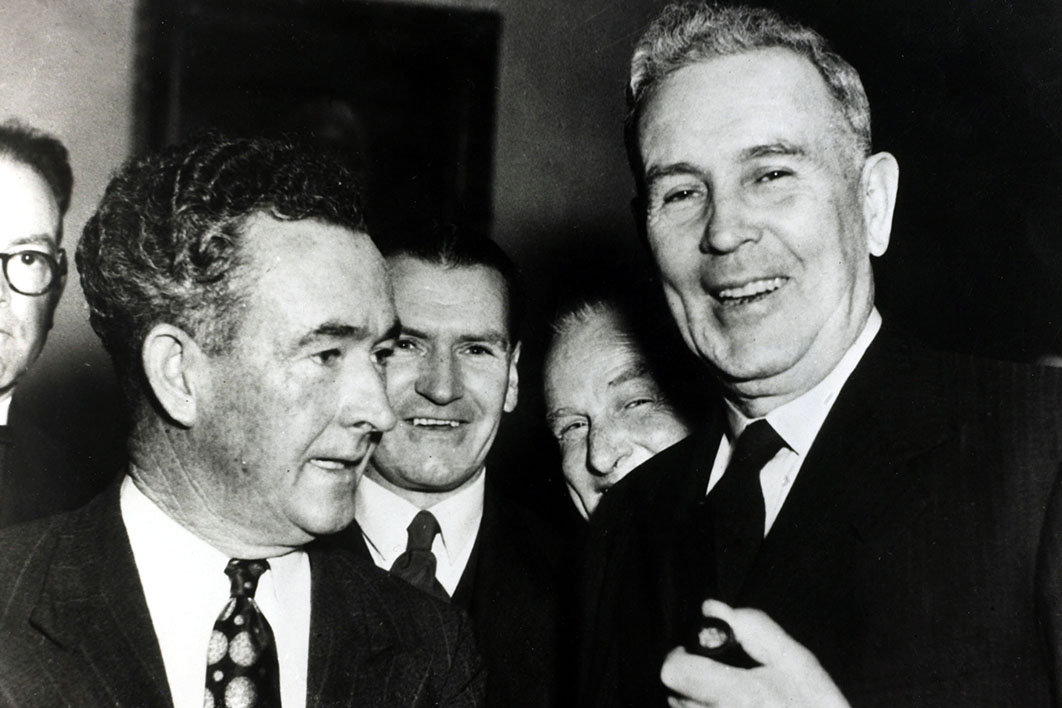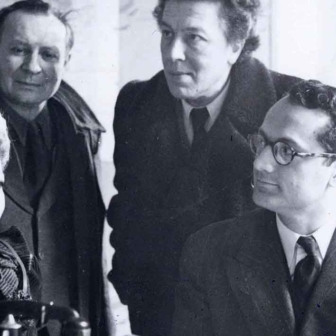As is often the case with any set of complicated and perplexing events, there are optimistic and pessimistic ways of looking at where we might go from here, and how life will look on the other side of the pandemic. When we engage in this kind of speculation, we tend to be either projecting our personalities, sunny or dark, or using historical analogies. That’s one reason why a historian might have something useful to say.
History can offer insight, but it can just as easily mislead. So what I do here is refer to three historical analogies — the first world war and Spanish flu epidemic, the Great Depression, and the second world war and postwar reconstruction — and to see where they might take us.
The first is perhaps the most obvious, given that the crisis we have faced has been, at its heart, one of public health. By 1918, the war had killed millions of soldiers and civilians. But when American troops arrived on the Western Front that year they brought with them a virulent strain of influenza that, according to some estimates, would eventually kill as many as one hundred million people.
Its first Australian victims were soldiers far from home. But, as in 2020, Australia was in the fortunate position of having advance warning of what was on the way, and a maritime quarantine was imposed. That probably minimised the damage, though Australia still probably lost somewhere between 15,000 and 20,000 people to the illness — many more, one hopes, than now seems likely from Covid-19.
Is there anything in this experience that might point to the fate of progressive ideas on the other side of our own pandemic? Not much, I’m afraid. Australia’s gross domestic product had shrunk during the war, and it grew in the wake of the Spanish flu. The flu, with its absenteeism, closure of businesses, and state border and port restrictions, certainly disrupted economic activity, as did industrial conflict during 1919, some of it related to workers’ concerns about the flu. But much of life went on as before. While restrictions were most severe in New South Wales, they were on the whole much less onerous than at present. The Victorian Football League, for instance, predecessor to the Australian Football League, continued its season as usual.
Neither the war nor the flu unleashed any burst of policy creativity among progressives. It’s true that the Labor Party moved leftward, adopting a socialisation objective in 1921, but the lean interwar years saw no great advance in social protection, as distinct from efforts to protect Australian urban and rural industry with tariffs and subsidies. Australian society had been divided by the war and its aftermath, and progressive advance of an enduring kind in this country has generally emerged out of policy consensus, not fierce contestation.
The Great Depression struck just as dramatically. Australia’s unemployment rate peaked at perhaps 25 per cent in the early 1930s, and the economy again shrank. It is hardly surprising that pessimists in the present wonder whether we’re heading into a comparable situation. My answer to that is that while there are likely very tough times ahead, we should be careful about easy comparison.
The macroeconomic capacity of the federal government in 1930 was much weaker than today. The monetary capacity of the central bank of the day, the Commonwealth, was piddling compared with the kind of activity we’ve witnessed just in the last few weeks. Our welfare state has many deficiencies in 2020, but it was rudimentary in 1930, lacking an unemployment benefit, for instance, leaving aside a new and very basic system of insurance in Queensland. Australians in 2020 will demand and receive more protection from their government than those of ninety years ago.
On the other hand, Australia’s economy was very simple in 1930, and ours isn’t. Exports then were dominated by wool and wheat; the crisis for Australia, to a great extent, arose from the plunge in prices for those commodities, with an accompanying retreat of overseas loan funds. The growing manufacturing sector, developing behind a rising tariff wall, was mainly engaged in import replacement. Few married women were in paid work and it’s quite possible that the women who were — often young and single — were generally less affected by the downturn because the industries in which they worked were a little less vulnerable to the bust than male-dominated building and construction, and transport. The household economy usually comprised a man engaged in paid work, and a woman in unpaid labour in the home.
The unfolding economic crisis of the present is obviously different, but no less potentially devastating for that. Initially at least, jobs in the services sector have seemed extremely vulnerable to social-distancing measures, and the women — a much greater proportion of the workforce than in 1930 — who are so well represented in this sector are vulnerable to lay-offs. Our export sector depends on services — education, for instance, and tourism — to an unprecedented degree, and our economy is integrated and interconnected globally, through movements of people, capital and goods, in more complex ways than in 1930. Australia had accepted many immigrants in the 1920s, but it is now arguably more vulnerable to the drying up of immigration, which plays a more complex role in the economy than a century ago.
In the 1930s, Australia’s economic recovery was shaped to a great extent by that of Britain. Today, we tend to look nervously to China, but our fate will also be tied to that of the United States as the world’s largest economy.
The Depression remains Australia’s emblematic historical experience of economic collapse and social distress. But I’m unsure that it offers us too many clues about what the coming crisis will be like. At best, it might act as a reminder that progressive policies don’t usually flourish in times of such distress; that economic crises, in our country’s history, have more often provided a cover for conservative reaction, as they did in the 1930s and the 1970s.
It is with the second world war and postwar reconstruction that the optimists come into their own. Parallels have frequently been drawn between our current circumstances and the reconstruction policies developed from 1942 on, which remain our paradigmatic case of post-crisis reorganisation and renewal. While I don’t want to pour cold water over such hopes, I think it’s well to be cautious. But here are a few things we might take from that experience.
First, it began early, years before the war ended, and was intimately connected to the Allies’ articulation of war aims. In other words, it was connected to wartime propaganda and morale. I’ve seen few indications of our government, or any other, raising the hope and expectations of the population of a new world order afterwards. On the contrary, our own federal government, with its talk of “snapback,” has made it plain that, as far as possible, it will promote a return to business as usual. The hope of progressives is that this will prove impossible, as well it might.
Second, as Stuart Macintyre shows vividly in his brilliant study of postwar reconstruction, Australia’s Boldest Experiment, decisions made long before the end of the war were critical in shaping postwar Australia. If Labor had used the crisis of 1942 to push harder for more powers to be handed to Canberra, for instance, postwar governments would have experienced fewer constraints than they ended up facing.
In the present crisis, our federal government is making a lot of decisions right now that reflect its longstanding ideological preferences. These decisions will not be easily undone. Alongside proposing a massive handout to private schools, it seems to be using the opportunity to shrink the higher education sector even more drastically than is likely to occur anyway. Again, this is a long-term ideological preference, born of the conviction that too many Australians are attending universities and thereby wasting resources. We can expect much more of this kind of thing, some of which may well be nothing more complicated than the usual suspects seeking to loot the Treasury in familiar ways.
Third, unlike during and after the second world war, I see little or no evidence of an emerging policy consensus, which is usually a solid basis for progressive advance. Keynesianism emerged as the basis of government macroeconomic policy in Australia not under the Labor governments of John Curtin or Ben Chifley, but in November 1939, in the first Menzies government’s war budget. More generally, all of the political parties shifted decisively towards a greater emphasis on social protection and the welfare state in the 1940s. Child endowment was introduced by a conservative government, not Labor, in 1941.
Australia’s renovated economic policy and welfare state were forged more in consensus, underpinned by a new economic stability and emerging prosperity, than against a background of serious contention. And these changes were based, in large part, on recognition that the mass suffering of the Depression must be avoided at virtually all costs — that the war had shown that government actually had the instruments to ensure that ordinary people were not blown this way and that by whatever the prevailing economic winds happened to be.
I would like to believe these conditions currently exist. But I see a lot of evidence to the contrary. I see conservative politicians gearing up to use the level of debt we are likely to take out of this crisis as cover for reaction: for business tax cuts, for more assaults on unions, for cuts to the public sector, for a winding back of “red tape” and “green tape.” I see Labor politicians agreeing with them. Malcolm Turnbull’s recent memoir is a good reminder of how business tax cuts are as much an article of faith for Liberals like him as climate change denialism is for those he spends so much of his book excoriating.
There are other parallels with the 1940s that are other than reassuring. Many of the policies of the Labor governments of the 1940s ran into a rhetoric from the new Liberal Party that appealed to people’s desire to restore the status quo ante: a prewar order. This might seem odd given that before the war there had been the Depression, but I’ve read many letters written to Robert Menzies by ordinary constituents in the 1950s, and they are full of this kind of nostalgia. And he knew how to appeal to it.
This was the 1940s and 1950s version of snapback, and it’s a very powerful vision in times of uncertainty, as the global successes of the right-wing populists have already shown us. So when the Liberals complained of socialist regimentation and overregulation in the 1940s, they were appealing to the impulse — the fantasy — that life could be returned to what had been there before. But just because something is a fantasy doesn’t mean that it’s not based in realisty and powerful in its own way.
This is not a counsel of despair. It’s rather a warning that if we want change, if we want a more equal and a fairer society, it’s not going to fall into our laps compliments of coronavirus.
Clearly, some good things have come from the awful tragedy of the present crisis. Some welfare payments, especially for the unemployed, have been drastically increased to an extent that would otherwise have been impossible. Governments have been forced to recognise that the markets of neoliberal imagination are hopeless in responding to adult problems — something that should have been clear after 2008 but that has been muted in this country by our better economic performance compared with most other developed countries over the last decade or so. The federal system has worked more effectively than we might have expected. The unions are being consulted and listened to; the right-wing, climate-denialist commentariat isn’t.
And, perhaps most promisingly for social democrats, some degree of public trust in government has been restored. They need that. Rising public trust in government, in science, in the rational corners of the media: these are all really valuable resources for people who want to engage in evidence-based policymaking. We need to do our best to preserve and nurture these developments, along with the capacities for personal empathy and social solidarity that progressive policies ultimately rest on.
The federal government today has a deep and principled commitment to inequality, and no crisis is going to cure it of that. It is backed by business that would like nothing better than to be offered a few free kicks at a time when many industries will struggle for profitability, and that will be looking for relief from the tax office, the consumer and its own workforce. And Australia’s commercial media has never been better geared for giving conservative government and business what they want. While most kinds of business as usual are still a long way off, the familiar patterns of politics will probably be with us fairly soon. They could well be ugly. And we need to be ready. •




